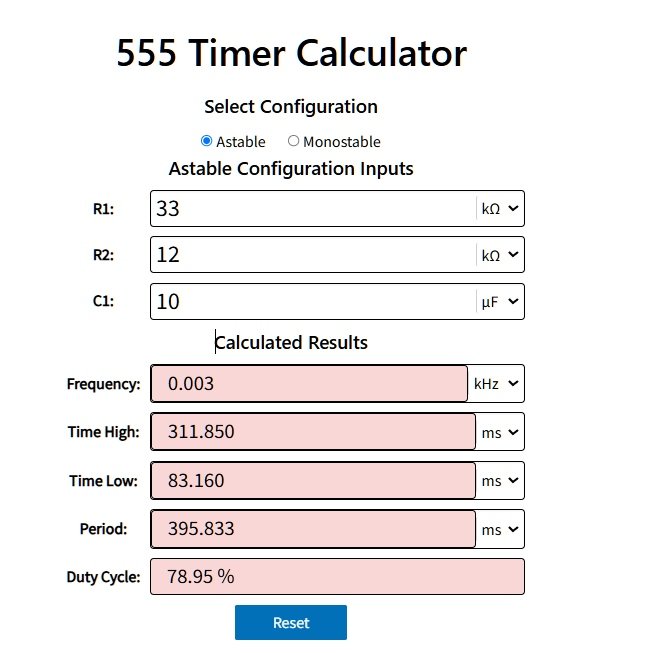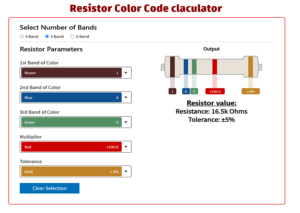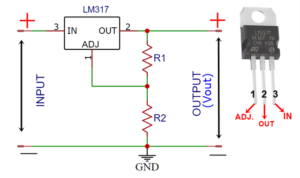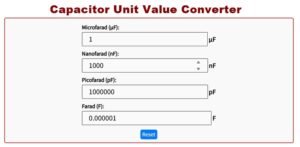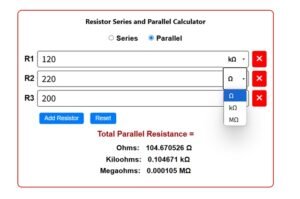555 Timer Calculator
Select Configuration
Astable Configuration Inputs
Calculated Results
Also try- LM317 Resistor Output voltage calculator
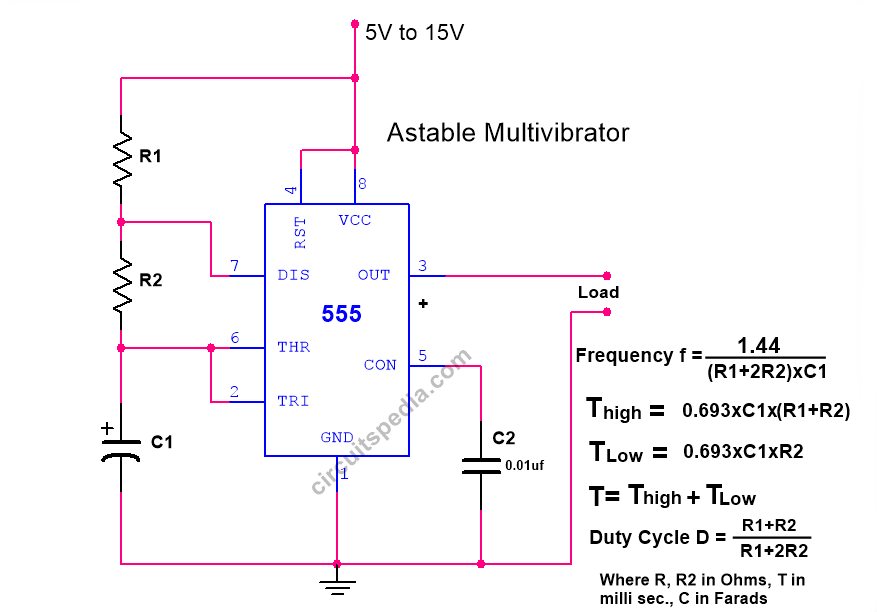

———————————–
555 Timer Mastery: Calculate Frequency, Period, and Pulse Width with Ease
The 555 timer IC (Integrated Circuit) is a true legend in the world of electronics. Dubbed the “workhorse” by many hobbyists and engineers, this inexpensive little chip is incredibly versatile. It can be used to create delays, generate pulses, or act as a simple oscillator (blinking lights, beeping sounds, etc.).
But how do you figure out exactly how fast it will blink, how long it will beep, or how wide its pulse will be? That’s where the calculations come in! Don’t worry, they look more complex than they are. We’ll break down the formulas for its two main modes: Astable and Monostable.
What Makes the 555 Tick? (A Mini Theory Bite)
Before the math, let’s briefly see what’s inside. The 555 timer has internal components like voltage comparators, a flip-flop, and a discharge transistor. These work together with just a few external components – typically resistors (R) and capacitors (C) – to control its output pin (Pin 3). The core idea is that the capacitor charges and discharges between specific voltage levels (1/3 of the supply voltage and 2/3 of the supply voltage), and the 555’s output changes state based on when these levels are crossed.
Mode 1: The Astable Oscillator (Creating Continuous Pulses)

In Astable mode, the 555 doesn’t need a trigger input; it simply oscillates, producing a continuous stream of pulses. Think of a blinking LED or a steady beeping sound. The circuit typically uses two resistors (R1 and R2) and one capacitor (C1).In astable multivibrator mode, the output is High and Low Continuously.
In astable mode, the 555 timer functions as an oscillator, continuously switching between HIGH and LOW states without requiring an external trigger.
Frequency (f) = 1.44 / {(R1 + 2R2) × C} Hz
Where:
- R1 & R2 = Resistors (Ω)
- C = Capacitor (F)
The capacitor (C1) charges through both R1 and R2 but discharges only through R2. This difference is key to the calculations.
Here are the essential formulas for Astable mode:
-
Time High (): The duration the output is HIGH. This is the time it takes for the capacitor to charge from 1/3 Vcc to 2/3 Vcc through R1 and R2. Thigh=0.693×(R1+R2)×C1 (Where 0.693 is approximately )
-
Time Low (): The duration the output is LOW. This is the time it takes for the capacitor to discharge from 2/3 Vcc to 1/3 Vcc through R2.
-
Period (): The total time for one complete cycle (HIGH + LOW). 1 It’s simply the sum of the high and low times. Substituting the formulas above:
-
Frequency (): How many cycles happen per second. Frequency is the reciprocal of the period. Substituting the period formula:
(Where 1.44 is approximately )
-
Duty Cycle: The percentage of time the output is HIGH during one cycle.
Important Note: In the standard Astable configuration, because depends on while depends only on , will always be greater than . This means the duty cycle will always be greater than 50%. If you need a 50% or less duty cycle, you’d need a slightly different circuit variation.
Units:
- R1, R2: Ohms ()
- C1: Farads (F)
- , , : Seconds (s)
- : Hertz (Hz)
- Duty Cycle: Percentage (%)
Using a calculator helps! Simply input your R and C values (remembering their units like kΩ, µF, nF, pF) into a 555 calculator to quickly get these results.
Mode 2: The Monostable Multivibrator (Creating a Single Pulse)
In Monostable mode (often called a “one-shot”), the 555 timer acts as a pulse generator. When it receives a brief trigger signal, its output goes HIGH for a specific, calculated duration, and then automatically returns to LOW. Think of a timer for a game buzzer or extending the press of a button.

The circuit of this mode is called a one-shot circuit. In the monostable mode of the 555 timer circuit. In this mode, the output produced a duration of a fixed set time (T). The output voltage becomes high for a set duration (T) when the pulse is detected at pin 2 of ic. The pulse detected at pin 2 is called a triggered pulse. The triggered pulse as a falling edge voltage.
The circuit typically uses one resistor (R1) and one capacitor (C1).
The time the output stays HIGH is determined by how long it takes the capacitor (C1) to charge from near 0V up to 2/3 Vcc through the resistor (R1).
Here is the essential formula for Monostable mode:
- The pulse duration is determined by the formula:T = 1.1 × R × C (seconds)Where:
R = Resistor value in ohms (Ω)
C = Capacitor value in farads (F)
Units:
- R1: Ohms ()
- C1: Farads (F)
- : Seconds (s)
Again, make sure your R1 and C1 values are converted to Ohms and Farads respectively before plugging them into the formula, or use a calculator that handles unit conversions for you.
Why Calculate?
Knowing these formulas and being able to calculate the expected timing is crucial for designing circuits. Whether you need a specific blink rate for an indicator, a precise delay for a system, or a certain length of pulse, these calculations allow you to select the right resistors and capacitors to achieve your desired outcome.
While manual calculation is great for understanding, online calculators make the process fast and easy, allowing you to quickly test different component values.
Conclusion
The 555 timer remains a cornerstone component in electronics prototyping and design due to its simplicity and flexibility. By understanding the basic principles of its Astable and Monostable operations and using the straightforward formulas (or a handy online calculator!), you can accurately predict and control the timing behavior of your circuits. So grab some 555s, resistors, and capacitors, and start experimenting!
More Tools
- SMD Resistor Code Calculator
- Ceramic capacitor code calculator
- Battery charging time calculator
- Capacitor series -parallel calculator

